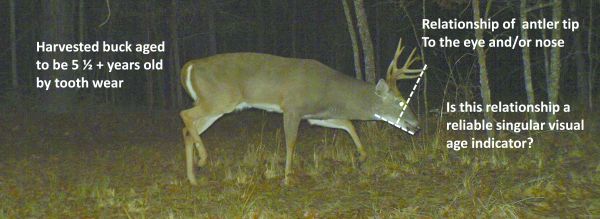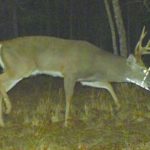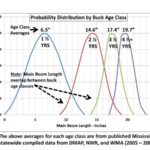
It’s not quite so simple
In the March installment of Happy Trails, we looked at the topic of “aging bucks on the hoof,” paying particular attention to the possible use of certain visual geometric clues regarding the relationship of the tips of the antler beams to the eye and/or nose when viewed from the side as a way to reliably judge a given buck’s age in the field.
I had become intrigued by a recent article that I read in a national deer-hunting magazine that covered this same topic. According to the subject article, deer management personnel in a prominent northeastern state noticed in the mid-1990s a consistent pattern when the antler tip relationship to the eye was compared to actual tooth wear dated age on harvested bucks. For the following several years biologists and technicians with that state’s wildlife agency measured and noted the parameters of this relationship as they compiled harvest data from several management cooperatives.
This particular measurement and method was reported to be quite reliable for estimating a buck’s actual age in one of four general age classifications, either as a 1 ½-year-old yearling, a 2 ½-year-old, a 3 ½-year-old, or a 4 ½ + year old.
The basis for this method involves the fact that, generally, as a whitetail buck gets older, his main beams continuously develop outward and down, as well as forward and down. It was reported that after ground-checking more than 2,000 bucks over a several-year period and comparing lower jaw tooth wear age with the antler tip-to-eye relationship, the method was found to be surprisingly accurate in that particular deer population.
The central question to me was whether that same measurement pattern be translated into an accurate, visual, absolute buck aging tool for those of us here in the Deep South?
Following recent telephone conversations and e-mail exchanges with several very knowledgeable local and regional deer scientists, the short answer is a qualified “no.”
Even though in general, a buck’s antler beams do indeed continuously tend to develop outward and down, as well as forward and down, with age, the overlap in relative antler size between successive annual buck age classifications is too great for this method alone to be used to visually age a buck into a single annual age class with a reasonable degree of accuracy.
As plainly shown on the accompanying illustration, when one graphs the probability distribution of main beam length or gross B&C score in a given sample buck population, it yields what is commonly called a bell-shaped curve for each annual buck age class. Each annual age class bell curve has overlap with the preceding and succeeding annual age classes in any given deer population, i.e. the probability curve for a typical population of 2 ½-year-old bucks overlaps with both the younger 1 ½-year-old group and also with the older 3 ½-year-old group, and so on.
In other words, in each given annual buck age classification, you will find smaller-than-normal or low-end individuals, normal-sized or typical individuals, and larger-than-normal or high-end individuals. We can all attest from our own observations in the field that there are younger bucks with larger-than-normal antlers and older bucks with smaller-than-normal antlers.
As one can readily see on the graph, regarding main beam length, or by extension B&C gross score, a buck that is a high-end 2 ½-year-old antler-wise could be the equivalent of and be visually comparable to a low-end 3 ½-year-old buck — and in an extreme case even a low-end 4 ½-year-old buck.
And therein lies the main problem with using the singular visual clue of antler tip relationship to the eye to age a buck on the hoof.
However, recent deer research at the Mississippi State University Deer Lab has documented that a high degree of accuracy (85 percent) can be obtained when estimating a buck’s age using a combination of antler and body characteristics.
Using known-age bucks captured on trail camera photos, researchers were able to accurately classify bucks into three age categories, which happen to coincide with a buck being classified as young, middle aged or mature. The age categories are: 1 ½ or 2 ½ years old, 3 ½ or 4 ½ years old and 5 ½ plus years old.
Furthermore, the MSU Deer Lab’s Buckscore software will soon allow the average deer hunter to utilize this innovative technology via a user-friendly application (future release date is to be determined).
In my experience, the accuracy of all visual aging methods decline when applied to hunter eyeball field estimates under conditions that are usually less than ideal. Harvest decisions are often made in a hurry under duress, so self-education, familiarization with field aging criteria and the use of technology like Buckscore ahead of time is essential. After all, on-the-hoof field aging of white-tailed deer is nothing more than a calculated guess, so the more factual evidence that goes into the calculation the better.
It is my belief that here in Mississippi where I have had most of my experience over the past 40 plus years observing white-tailed deer, the physiological differences between age classifications can in some locales be more skewed than elsewhere. This could be due to the fact that decades ago, when Mississippi was working hard to repopulate its deer herd, captive deer were brought in and released from deer populations far removed from Mississippi. This had the effect of genetically blending physiological characteristics regarding body size and conformation and antler size from elsewhere, sometimes from locales hundreds of miles away, into the state’s residual deer population.
In conclusion, the best and most accurate way to successfully age bucks on the hoof under real-life field conditions is to use the totality of what can be observed. The most reliable indicators of a buck’s age or relative age are still the old standards: physiological body characteristics, patterns of behavior and relative antler size.
For this reason, we should all familiarize ourselves with the general physical criteria for aging and sexing deer in our respective locales before harvest. We are all human and a few mistakes will happen, but an honest mistake is an opportunity to learn and not repeat the mistake again.




